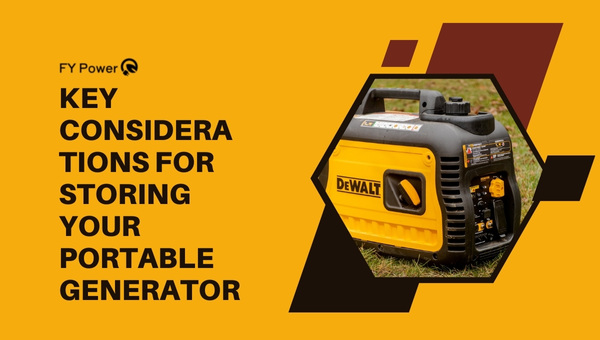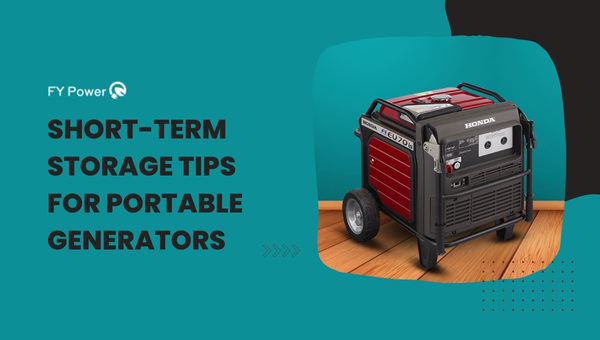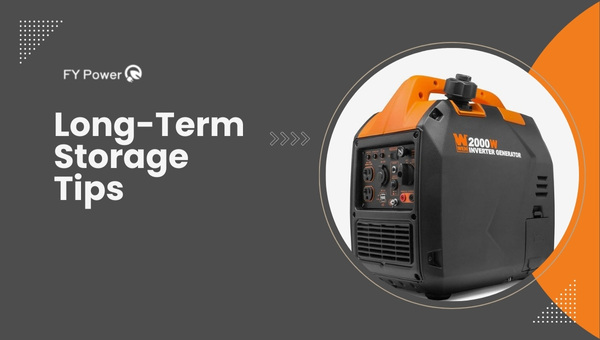If you own a portable generator, you know that it can be a lifesaver during a power outage or when you need to power tools or appliances in remote locations. But when it comes to storing your generator, there are some important things to consider.
Whether you’re storing your generator short-term or long-term, there are steps you can take to ensure that it remains in good condition and is ready to use when you need it.
Short-term storage typically refers to storing your generator for a few weeks or months, while long-term storage refers to storing it for six months or longer. Regardless of how long you plan to store your generator, the first step is to prepare it for storage.
This includes cleaning the generator, checking the oil level, and draining the fuel system. You’ll also want to remove any attachments, such as cords or adapters, and store them separately.
By taking these steps, you can help prevent damage to your generator and ensure that it’s ready to go when you need it.
Key Considerations for Storing Your Generator
As an owner of a portable generator, it’s essential to know how to store it correctly to maintain its longevity and ensure it’s always ready to use when you need it. Whether for short or long-term storage, here are some key considerations to keep in mind:

1. Location
Store your generator in a dry and well-ventilated area. It’s best to keep it indoors to prevent rust, corrosion, and exposure to extreme weather conditions. If you must store it outdoors, make sure to cover it with a waterproof and UV-resistant cover.
2. Fuel
Before storing your generator, make sure to drain all the fuel from the tank and carburetor, especially if you plan to store it for an extended period. Storing the generator with fuel inside can lead to varnish build-up in the carburetor, which can cause starting and running problems.
3. Oil
Change the oil before storing your generator, even if you haven’t reached the recommended number of hours for an oil change. Used oil contains contaminants that can corrode your engine over time. Also, be sure to use oil with the recommended viscosity and type as specified in your generator manual.
4. Battery
If your portable generator has a battery, remove it before storage and store it separately. Batteries can discharge over time, and leaving it attached to the generator can lead to corrosion.
5. Run it occasionally
For long-term storage, consider running your generator occasionally to keep the engine lubricated and prevent corrosion. Running it for 10-15 minutes every month can help keep the engine in good shape.
By following these key considerations for storing your portable generator, you can ensure its readiness and longevity while also preventing any damage. Remember to consult your generator manual for additional storage instructions specific to your generator model.
Read: 10+ Tips To Choose The Best Generator For Construction Sites
Short-Term Storage Tips for Portable Generators

When storing your generator for a short period, such as a few weeks or months, there are a few things you should consider to ensure that it remains in good condition and is ready for use when you need it.
Here are some essential tips to guide you through the process:
- Store your generator in a dry and well-ventilated place, preferably in a garage or shed, to protect it from dust, moisture, and other harmful elements.
- Before storing your generator, power it off and let it cool down for at least 15 minutes. Then, drain the fuel tank and the carburetor to prevent the fuel from becoming stale and gumming up the carburetor. Use a fuel stabilizer to avoid clogging the carburetor, too.
- Clean your generator’s exterior and remove any debris, dirt, or dust buildup. You can use a soft brush or a vacuum cleaner to get rid of the dirt.
- Check your generator’s oil and filter levels and change them if necessary. Dirty oil can damage your engine if you start the generator in the future, so it’s essential to change it regularly.
- Finally, cover your generator with a protective covering, such as a tarp, to safeguard it from dust, dirt, and other damages. Ensure to leave enough space for air circulation when covering your generator.
By following these simple short-term storage tips, you can protect your generator from damage and ensure it runs smoothly when needed.
In the next section, I’ll share some long-term storage tips to help you store your generator safely for an extended period.
Long-Term Storage Tips
Proper storage of a portable generator is essential to extend its lifespan and ensure that it functions effectively when needed. If you plan to store your generator for more than 30 days, you need to follow a specific storage process to minimize damage from corrosion, rust, and stale fuel.

Here are some long-term storage tips for your generator:
- Clean the Generator
Before storing your generator, make sure to clean it thoroughly using a soft brush and damp cloth. You should remove all debris, dirt, or grime on the surface and ensure that it’s dry before storing it. This will prevent the buildup of dust, which can clog the filters or reduce the generator’s performance.
- Change the Oil and Filter
Stale oil can damage your generator’s engine, especially during long-term storage. Before storing your generator, change the oil and oil filter to prevent corrosive damage caused by contaminants, acids, and moisture. Using fresh oil and a clean filter will also protect the engine and ensure that it starts easily when you need it later.
- Add Fuel Stabilizer
Fuel stabilizer is an essential additive that helps preserve gasoline in your generator’s fuel system. If you plan to store your generator for more than 30 days, add a fuel stabilizer to the gas tank and run the generator for a few minutes to circulate it through the fuel lines. This process will prevent the fuel from becoming stale, oxidizing, or gumming up in the carburetor.
- Empty the Fuel Tank
If you don’t plan to use your generator for several months, it’s better to empty the fuel tank before storing it. You can do this by running the generator until it runs out of gas or by using a fuel siphon to drain the tank. This will prevent condensation from forming inside the tank, which can lead to corrosion or rust.
By following these long-term storage tips, you can ensure that your generator remains in good condition and ready to use whenever you need it. Properly stored generators can last for many years, saving you money and providing you with reliable backup power during blackouts or emergencies.
Also Read: Why My Generator Is Not Starting? 9 Reasons With Solution
Things To Look For While Bringing Your Portable Generator Out of Storage
Whether you are planning for short-term or long-term storage, there are different conditions to consider before making your generator operational again.
Short-Term Storage
If you have stored your generator for short-term storage, meaning less than a month, you can bring it out when you need it. However, it is important to perform a few checks before using it to ensure that it is in good working condition. Here is a checklist of things to do:
- Check the oil and fuel levels and refill them as necessary.
- Inspect the generator for any damage or wear and tear.
- Test the generator by starting it up and running a few appliances to make sure everything works properly.
Long-Term Storage
If you have stored your generator for long-term storage, meaning more than a month, there are a few things to consider before bringing it out. Here are some tips to follow:
- Check the Battery
If your generator has a battery, it is important to check its condition before using it. A battery that has been left idle for a long time can lose its charge and become damaged. Before starting your generator, check the battery’s voltage level and charge it if necessary.
- Inspect the Fuel
When gasoline sits for too long, it can become stale and gum up the carburetor. Drain and refill the tank with fresh gasoline to avoid such problems.
- Change the Oil
Change the oil and oil filter to avoid engine damage from old or contaminated oil.
- Conduct a thorough Inspection
Check the air filters, spark plugs, fuel hoses, and other parts for any signs of damage, wear and tear, or deterioration.
- Run a Load Bank Test
Before using your generator, it is recommended to run a load bank test to ensure that it can handle the expected load. This test will also help to identify any issues with the generator.
By following these tips, you can ensure that your portable generator is always in good working condition and ready to use when you need it.
Conclusion
Storing a portable generator properly is vital to ensure its longevity and optimal performance. Whether you plan on storing it short-term or long-term, there are certain steps you can take to protect your investment.
Firstly, you need to ensure the fuel is properly stabilized to prevent it from going stale or corroding the generator’s carburetor. You can do this by using a fuel stabilizer or draining the fuel entirely.
Secondly, you need to clean the generator thoroughly and protect it from the elements. Covering it with a weatherproof cover and storing it in a dry, cool place will prevent dust, debris, and moisture from damaging the unit.
Lastly, performing regular maintenance checks, such as oil changes and filter replacements, is essential as part of your storage routine. This will help avoid any potential problems or malfunctions when you’re ready to use your generator again.
Following these simple steps will help you store your portable generator properly and ensure it remains reliable and ready for use when you need it most.

